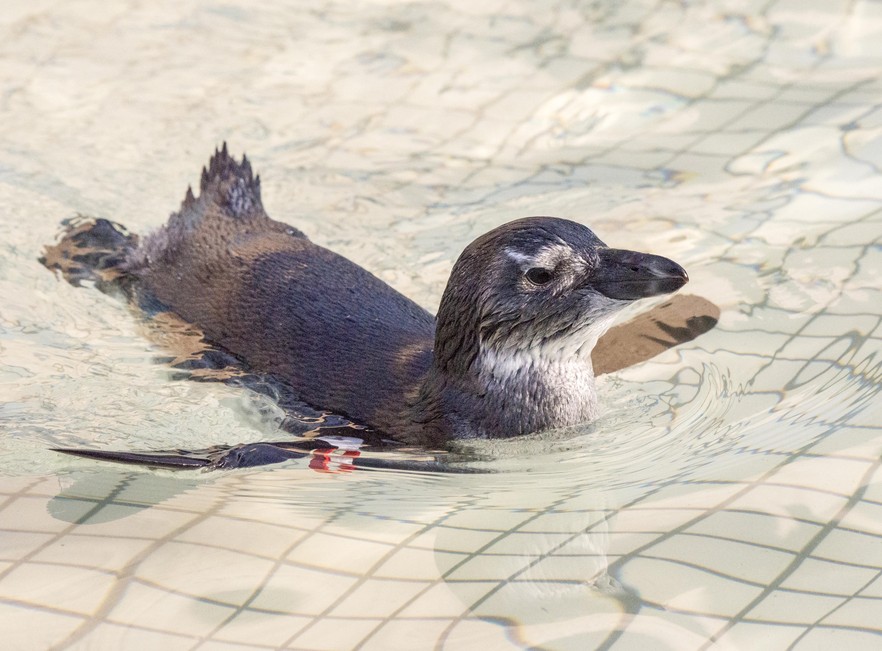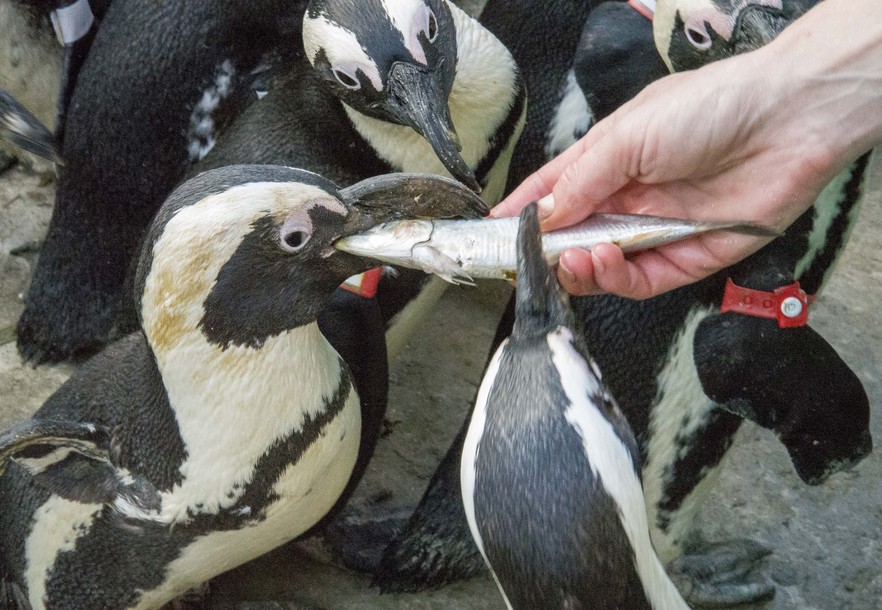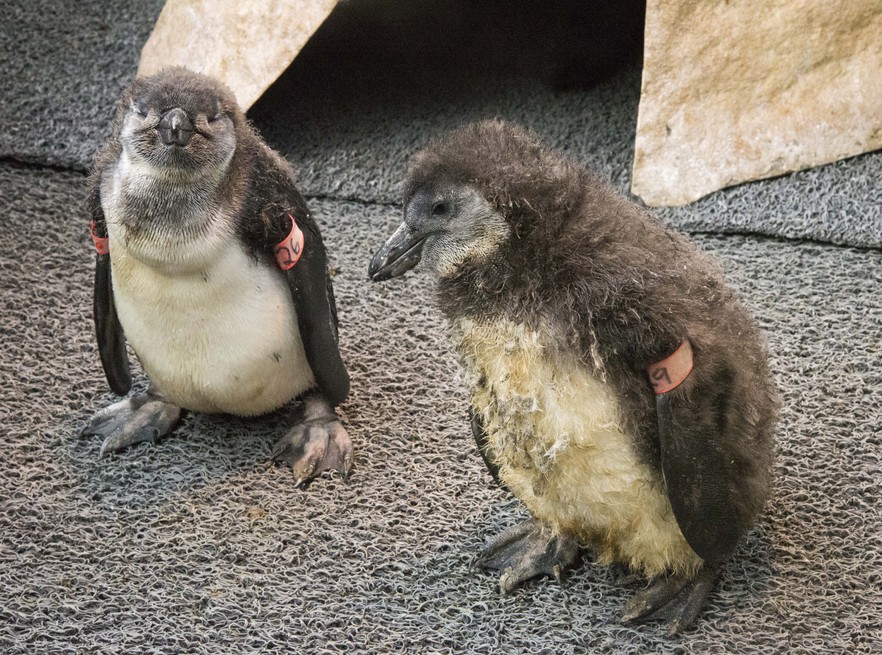Latest science confirms plummeting penguin population
New model forms the basis for an urgent recommendation to change African Penguin’s conservation status from endangered to critically endangered
A cleaned African Penguin swimming at SANCCOB’s Rietvlei centre in 2018. Photos: John Yeld
On June 23 2000, when – like now – Cape Town was in the icy grip of mid-winter, South Africa suffered what was called the world’s worst coastal seabird environmental disaster.
That was the day when the fully laden ore-carrier MV Treasure broke up and sank some 8km north of Robben Island while a salvage tug was attempting to tow it to safety.
The stricken vessel spilled more than 1,100 tons of highly toxic heavy fuel oil into the ocean, covering with oil tens of thousands of African Penguins from two major breeding colonies nearby: Robben Island and Dassen Island slightly further north. Together these colonies supported more than 40% of the global population of these penguins.
Within ten days of the spill, more than 20,000 severely oiled penguins and other seabirds had been admitted into a hastily assembled rehabilitation centre at Salt River where an international team worked frantically to clean the stricken birds. In a miraculous rescue effort, some 38,500 individual penguins were either cleaned and released after being oiled, or captured and moved hundreds of kilometres away to stop them from becoming oiled.
An African Penguin is fed a pilchard during rehabilitation at SANCCOB’s Rietvlei centre in 2018.
Fast forward just 24 years – the blink of an eye on an evolutionary time-scale – and there are currently only about 31,700 individual African Penguins left across the full home range of this species that stretches from Namibia to the Eastern Cape.
Almost unimaginably, this means there are now several thousand fewer penguins left in the entire population than were saved from oiling during the single MV Treasure disaster.
Census reveals staggering rate of decline
This staggering rate of decline in the penguin population is confirmed in a paper titled The African Penguin Spheniscus demersus should be considered Critically Endangered, published online last week (July 10) in the scientific journal Ostrich: Journal of African Ornithology.
The lead author is Dr Richard Sherley of the Environment and Sustainability Institute/Centre for Ecology and Conservation at the University of Exeter in Cornwall, UK. His 11 co-authors include prominent local scientists, managers and conservationists in the field of African Penguin research.
Sherley and his colleagues collected data on penguin breeding pairs from censuses conducted at 26 colonies in three regions in South Africa and Namibia between 1979 and 2023. They then analysed the counts of these breeding pairs to determine the rate of decline and the species’ conservation status, in line with the methodology of the IUCN (International Union for Conservation of Nature) Red List – that is, whether a species is endangered, critically endangered, vulnerable, or one of the other nine categories for classifying species at high risk of global extinction.
Their calculations indicated that the African Penguin probably met the criteria in the relevant IUCN methodology statements to be listed as “critically endangered”.
Final decision on 22 October
Nina Braude, senior attorney at the Biodiversity Law Centre, said the work of Sherley and colleagues served two purposes. First, it was published as a scientific paper to contribute to wider scientific discussions and knowledge development. Second, it forms part of the scientific submission arguing that the threat status of African Penguins should be raised from “Endangered” to “Critically Endangered” on the IUCN’s Red List of Threatened Species.
“So Dr Sherley and colleagues simultaneously drafted the academic article for Ostrich and prepared a submission to the IUCN,” she explained.
A pair of orphaned African Penguin chicks rescued from a breeding island and taken to SANCCOB for hand-rearing. The species’ population status is so dire that efforts are made to save every single individual bird.
The IUCN has specific procedures which need to be followed when making submissions of this nature, and it uses designated “Red List Authorities” to assist with threatened status assessments. When it comes to birds, BirdLife International is the global authority responsible for co-ordinating this evaluation, ensuring that the size and trend of bird populations are assessed and that the assessments are subject to consultation through the organisation’s Globally Threatened Birds Forums.
Using the Ostrich paper as its scientific basis and after additional consultation, BirdLife International recommended the change in the listing of these penguins to the IUCN.
The IUCN has indicated that, after checking this assessment in its own structures, it will publish a final decision on 22 October.
More penguins lost in ten years than now exist
Sherley and colleagues point out in their paper that although the total population size at the start of the 20th century is unknown, the African Penguin may have been the region’s most abundant seabird, with between 1.5 and three million individuals across its range.
“By 1956, only around 300,000 individuals remained, and the population has declined consistently since then, apart from a brief recovery in the late 1990s and early 2000s.”
Since this first formal attempt to estimate the species’ population size in 1956, the penguin’s conservation status has been reviewed several times.
In 1984, the species was considered to have met the criteria to be listed on the IUCN’s Red List as “Vulnerable”, and by 2007 it had been uplisted to “Endangered”.
Apart from a short period around 2000, the African Penguin population has been in constant decline since at least the 1950s, the authors explain.
Their paper makes what they describe as four key observations:
- The global rate of decline over the last ten years (one penguin generation) has nearly doubled, from 4.3% per annum in the 2019 assessment to 7.9% in 2023.
- The annual rate of decline over the last ten years was 9.9% in the Namibian section of the penguins’ range and 12.9% in the Eastern Cape section.
- This is the first time that the global breeding population of African Penguins has fallen below 10,000 pairs. Between 1979 and 2007, three islands each held more breeding pairs than the current global population for some periods. Dassen Island had about 11,000 pairs. as recently as 2007. Dyer Island had more than 10,000 pairs until 1990; and St Croix Island (Algoa Bay) held more than 12,000 pairs until 2003).
- The global population has more than halved in the last decade, largely because of the combined loss of more than 12,500 breeding pairs in Namibia (about 4,450) and the Eastern Cape (about 8,100) since 2015.
“In other words, substantially more birds (more than 25%) have been lost in less than ten years than now remain in the African Penguin population. Thus, it is not unreasonable to be concerned that — if these rates of decline persist — the species could become extinct in the wild by 2035.”
Support independent journalism
Donate using Payfast

Don't miss out on the latest news
We respect your privacy, and promise we won't spam you.
Next: SIU to investigate allegations of serious maladministration in Nelson Mandela Bay
Previous: We had no water to put out the flames, say victims of Durban shack fire
Letters
© 2024 GroundUp. This article is licensed under a Creative Commons Attribution-NoDerivatives 4.0 International License.
You may republish this article, so long as you credit the authors and GroundUp, and do not change the text. Please include a link back to the original article.
We put an invisible pixel in the article so that we can count traffic to republishers. All analytics tools are solely on our servers. We do not give our logs to any third party. Logs are deleted after two weeks. We do not use any IP address identifying information except to count regional traffic. We are solely interested in counting hits, not tracking users. If you republish, please do not delete the invisible pixel.



